BS4107: Theory Assessment 2 - Medical Questions and Pathogens
VerifiedAdded on 2022/12/01
|7
|1896
|176
Homework Assignment
AI Summary
This assignment addresses five key questions in medical biology. The first question defines true and opportunistic pathogens and explains how they cause disease, supported by examples. The second question describes the two main types of T lymphocytes, their receptors, and antigen processing and presentation. The third question details the influenza virus life cycle in a human host and explains why multiple infections are possible. The fourth question defines probiotic microorganisms and evaluates their benefits to human health. Finally, the fifth question outlines four methods used to diagnose viral infections, using named pathogens to illustrate each method. The assignment incorporates cited references to support the information provided, offering a comprehensive overview of the topics covered.
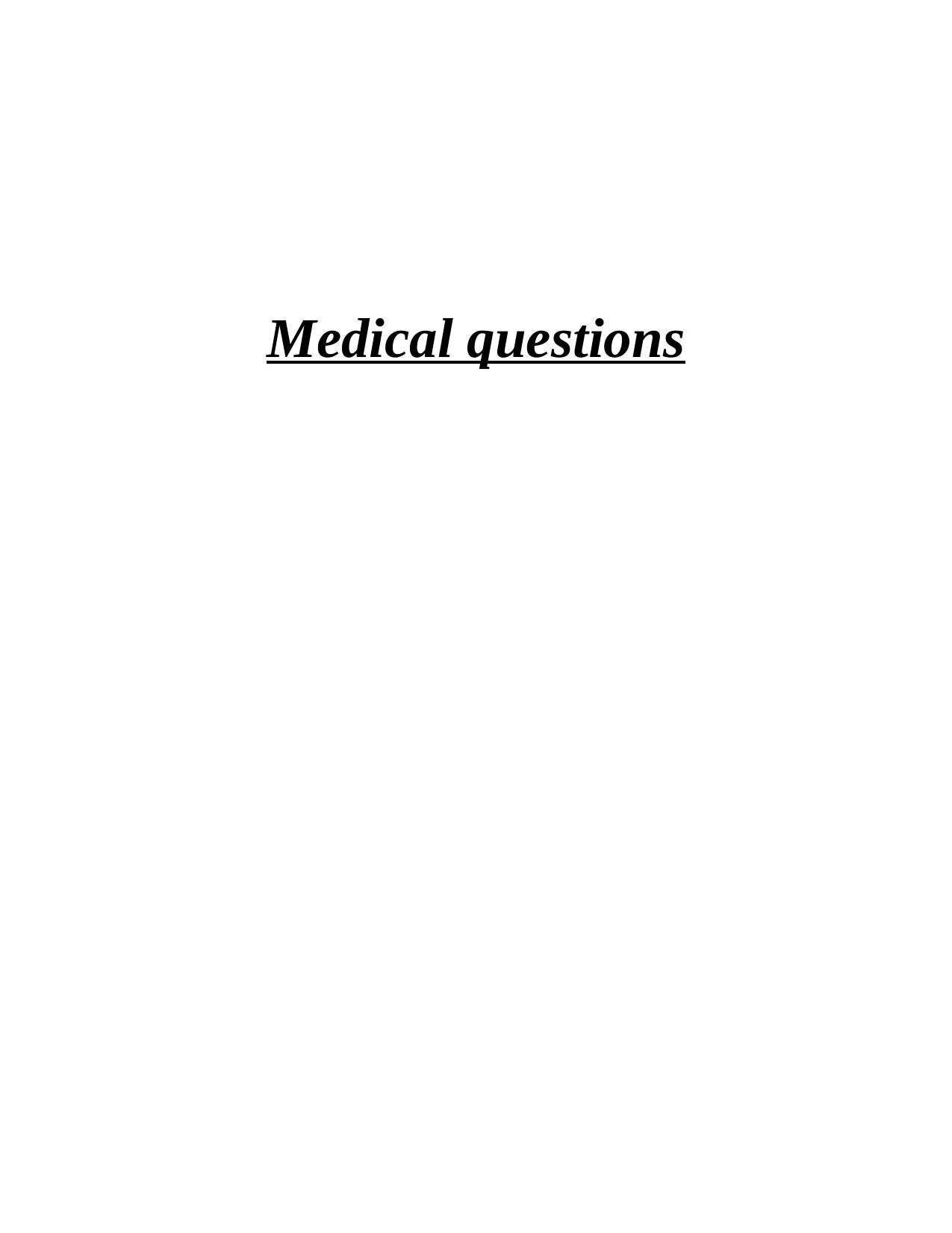
Medical questions
Paraphrase This Document
Need a fresh take? Get an instant paraphrase of this document with our AI Paraphraser
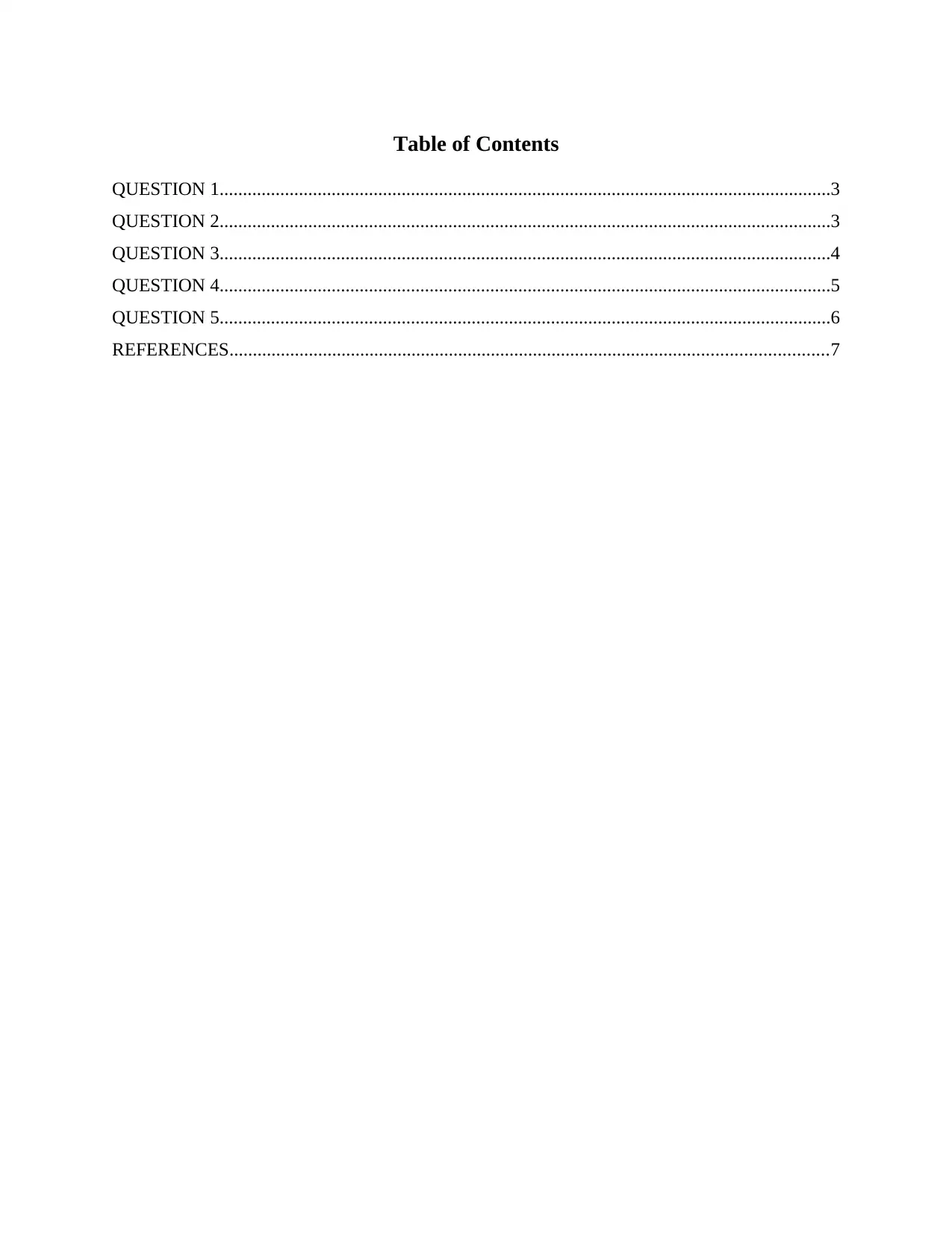
Table of Contents
QUESTION 1...................................................................................................................................3
QUESTION 2...................................................................................................................................3
QUESTION 3...................................................................................................................................4
QUESTION 4...................................................................................................................................5
QUESTION 5...................................................................................................................................6
REFERENCES................................................................................................................................7
QUESTION 1...................................................................................................................................3
QUESTION 2...................................................................................................................................3
QUESTION 3...................................................................................................................................4
QUESTION 4...................................................................................................................................5
QUESTION 5...................................................................................................................................6
REFERENCES................................................................................................................................7
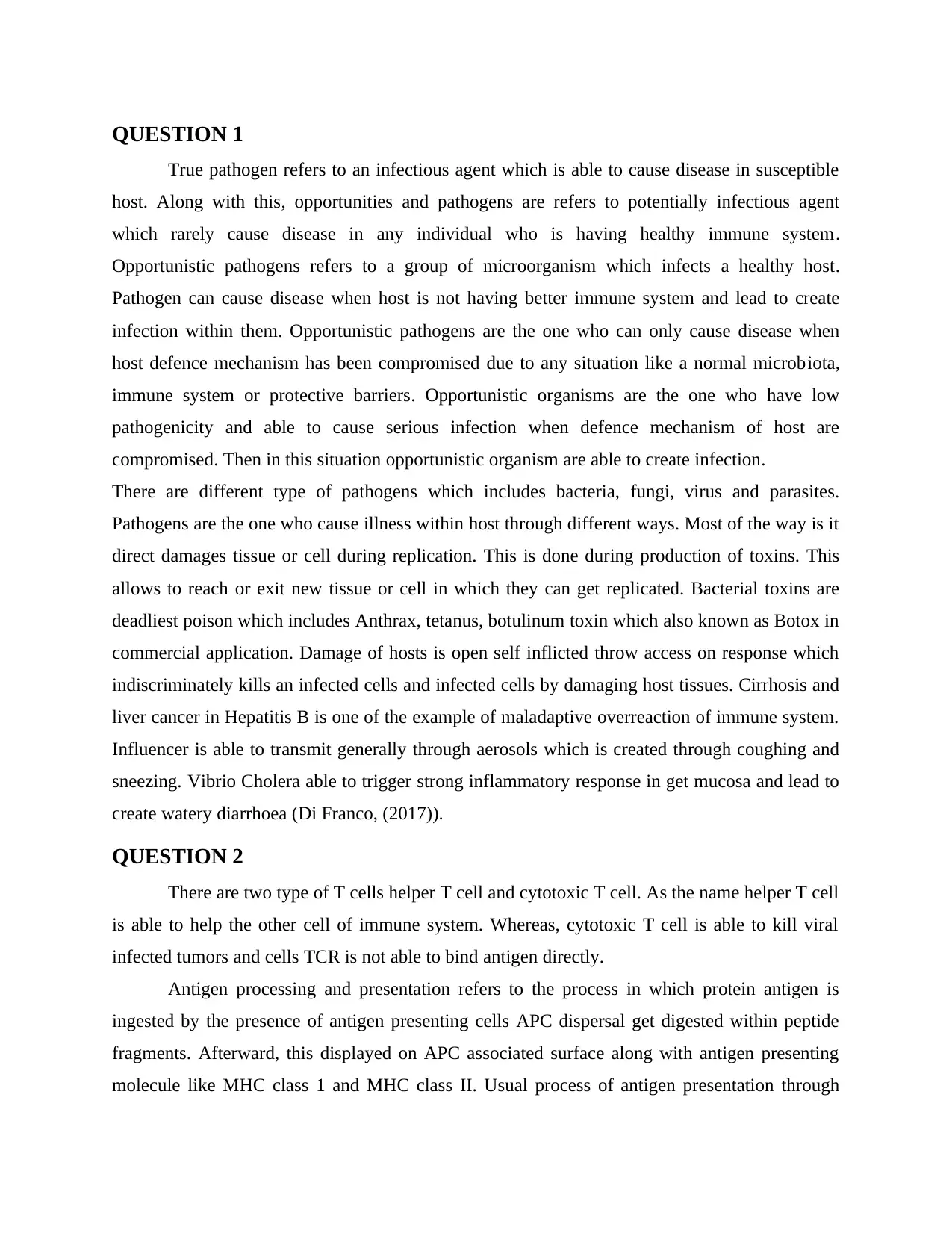
QUESTION 1
True pathogen refers to an infectious agent which is able to cause disease in susceptible
host. Along with this, opportunities and pathogens are refers to potentially infectious agent
which rarely cause disease in any individual who is having healthy immune system.
Opportunistic pathogens refers to a group of microorganism which infects a healthy host.
Pathogen can cause disease when host is not having better immune system and lead to create
infection within them. Opportunistic pathogens are the one who can only cause disease when
host defence mechanism has been compromised due to any situation like a normal microbiota,
immune system or protective barriers. Opportunistic organisms are the one who have low
pathogenicity and able to cause serious infection when defence mechanism of host are
compromised. Then in this situation opportunistic organism are able to create infection.
There are different type of pathogens which includes bacteria, fungi, virus and parasites.
Pathogens are the one who cause illness within host through different ways. Most of the way is it
direct damages tissue or cell during replication. This is done during production of toxins. This
allows to reach or exit new tissue or cell in which they can get replicated. Bacterial toxins are
deadliest poison which includes Anthrax, tetanus, botulinum toxin which also known as Botox in
commercial application. Damage of hosts is open self inflicted throw access on response which
indiscriminately kills an infected cells and infected cells by damaging host tissues. Cirrhosis and
liver cancer in Hepatitis B is one of the example of maladaptive overreaction of immune system.
Influencer is able to transmit generally through aerosols which is created through coughing and
sneezing. Vibrio Cholera able to trigger strong inflammatory response in get mucosa and lead to
create watery diarrhoea (Di Franco, (2017)).
QUESTION 2
There are two type of T cells helper T cell and cytotoxic T cell. As the name helper T cell
is able to help the other cell of immune system. Whereas, cytotoxic T cell is able to kill viral
infected tumors and cells TCR is not able to bind antigen directly.
Antigen processing and presentation refers to the process in which protein antigen is
ingested by the presence of antigen presenting cells APC dispersal get digested within peptide
fragments. Afterward, this displayed on APC associated surface along with antigen presenting
molecule like MHC class 1 and MHC class II. Usual process of antigen presentation through
True pathogen refers to an infectious agent which is able to cause disease in susceptible
host. Along with this, opportunities and pathogens are refers to potentially infectious agent
which rarely cause disease in any individual who is having healthy immune system.
Opportunistic pathogens refers to a group of microorganism which infects a healthy host.
Pathogen can cause disease when host is not having better immune system and lead to create
infection within them. Opportunistic pathogens are the one who can only cause disease when
host defence mechanism has been compromised due to any situation like a normal microbiota,
immune system or protective barriers. Opportunistic organisms are the one who have low
pathogenicity and able to cause serious infection when defence mechanism of host are
compromised. Then in this situation opportunistic organism are able to create infection.
There are different type of pathogens which includes bacteria, fungi, virus and parasites.
Pathogens are the one who cause illness within host through different ways. Most of the way is it
direct damages tissue or cell during replication. This is done during production of toxins. This
allows to reach or exit new tissue or cell in which they can get replicated. Bacterial toxins are
deadliest poison which includes Anthrax, tetanus, botulinum toxin which also known as Botox in
commercial application. Damage of hosts is open self inflicted throw access on response which
indiscriminately kills an infected cells and infected cells by damaging host tissues. Cirrhosis and
liver cancer in Hepatitis B is one of the example of maladaptive overreaction of immune system.
Influencer is able to transmit generally through aerosols which is created through coughing and
sneezing. Vibrio Cholera able to trigger strong inflammatory response in get mucosa and lead to
create watery diarrhoea (Di Franco, (2017)).
QUESTION 2
There are two type of T cells helper T cell and cytotoxic T cell. As the name helper T cell
is able to help the other cell of immune system. Whereas, cytotoxic T cell is able to kill viral
infected tumors and cells TCR is not able to bind antigen directly.
Antigen processing and presentation refers to the process in which protein antigen is
ingested by the presence of antigen presenting cells APC dispersal get digested within peptide
fragments. Afterward, this displayed on APC associated surface along with antigen presenting
molecule like MHC class 1 and MHC class II. Usual process of antigen presentation through
⊘ This is a preview!⊘
Do you want full access?
Subscribe today to unlock all pages.

Trusted by 1+ million students worldwide
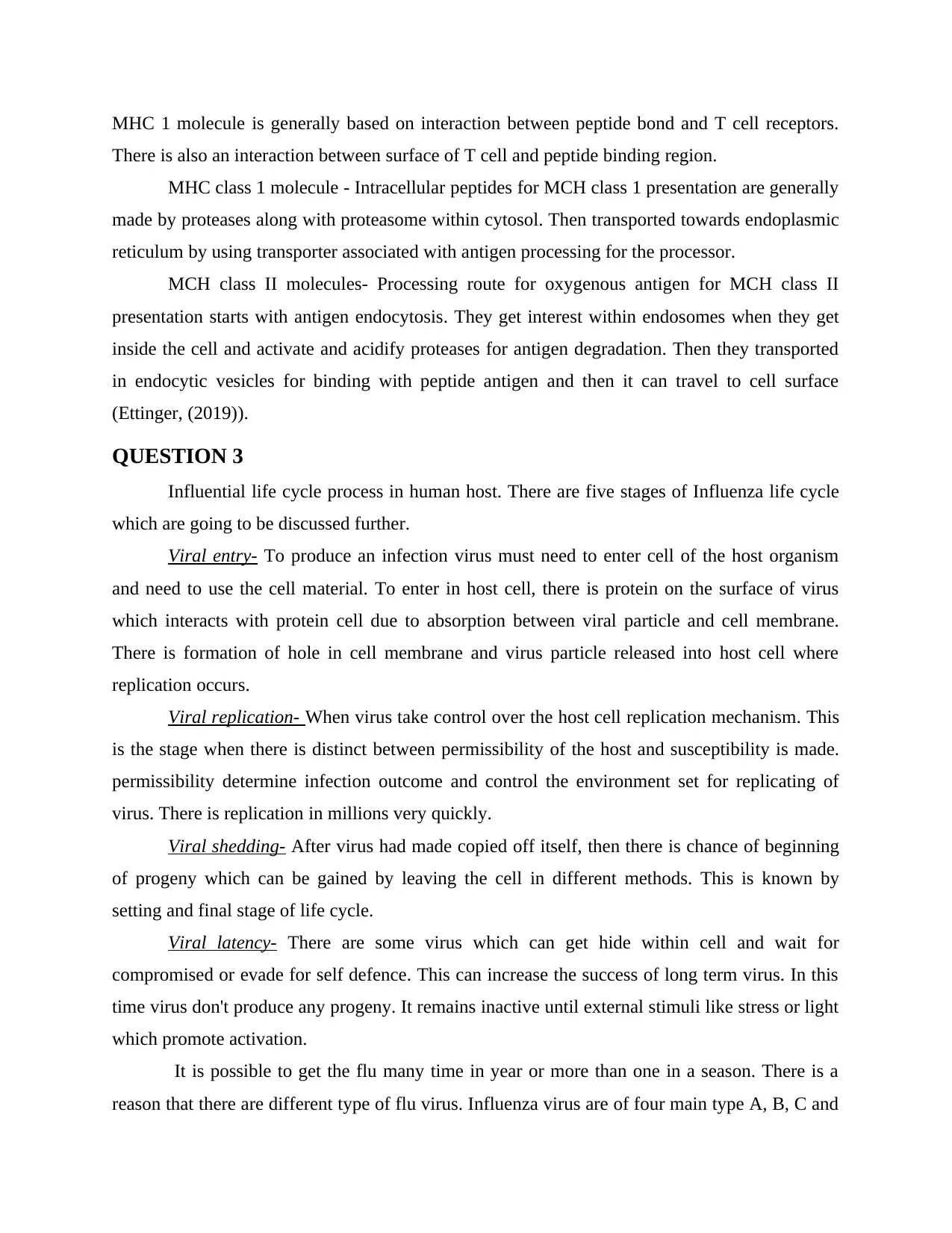
MHC 1 molecule is generally based on interaction between peptide bond and T cell receptors.
There is also an interaction between surface of T cell and peptide binding region.
MHC class 1 molecule - Intracellular peptides for MCH class 1 presentation are generally
made by proteases along with proteasome within cytosol. Then transported towards endoplasmic
reticulum by using transporter associated with antigen processing for the processor.
MCH class II molecules- Processing route for oxygenous antigen for MCH class II
presentation starts with antigen endocytosis. They get interest within endosomes when they get
inside the cell and activate and acidify proteases for antigen degradation. Then they transported
in endocytic vesicles for binding with peptide antigen and then it can travel to cell surface
(Ettinger, (2019)).
QUESTION 3
Influential life cycle process in human host. There are five stages of Influenza life cycle
which are going to be discussed further.
Viral entry- To produce an infection virus must need to enter cell of the host organism
and need to use the cell material. To enter in host cell, there is protein on the surface of virus
which interacts with protein cell due to absorption between viral particle and cell membrane.
There is formation of hole in cell membrane and virus particle released into host cell where
replication occurs.
Viral replication- When virus take control over the host cell replication mechanism. This
is the stage when there is distinct between permissibility of the host and susceptibility is made.
permissibility determine infection outcome and control the environment set for replicating of
virus. There is replication in millions very quickly.
Viral shedding- After virus had made copied off itself, then there is chance of beginning
of progeny which can be gained by leaving the cell in different methods. This is known by
setting and final stage of life cycle.
Viral latency- There are some virus which can get hide within cell and wait for
compromised or evade for self defence. This can increase the success of long term virus. In this
time virus don't produce any progeny. It remains inactive until external stimuli like stress or light
which promote activation.
It is possible to get the flu many time in year or more than one in a season. There is a
reason that there are different type of flu virus. Influenza virus are of four main type A, B, C and
There is also an interaction between surface of T cell and peptide binding region.
MHC class 1 molecule - Intracellular peptides for MCH class 1 presentation are generally
made by proteases along with proteasome within cytosol. Then transported towards endoplasmic
reticulum by using transporter associated with antigen processing for the processor.
MCH class II molecules- Processing route for oxygenous antigen for MCH class II
presentation starts with antigen endocytosis. They get interest within endosomes when they get
inside the cell and activate and acidify proteases for antigen degradation. Then they transported
in endocytic vesicles for binding with peptide antigen and then it can travel to cell surface
(Ettinger, (2019)).
QUESTION 3
Influential life cycle process in human host. There are five stages of Influenza life cycle
which are going to be discussed further.
Viral entry- To produce an infection virus must need to enter cell of the host organism
and need to use the cell material. To enter in host cell, there is protein on the surface of virus
which interacts with protein cell due to absorption between viral particle and cell membrane.
There is formation of hole in cell membrane and virus particle released into host cell where
replication occurs.
Viral replication- When virus take control over the host cell replication mechanism. This
is the stage when there is distinct between permissibility of the host and susceptibility is made.
permissibility determine infection outcome and control the environment set for replicating of
virus. There is replication in millions very quickly.
Viral shedding- After virus had made copied off itself, then there is chance of beginning
of progeny which can be gained by leaving the cell in different methods. This is known by
setting and final stage of life cycle.
Viral latency- There are some virus which can get hide within cell and wait for
compromised or evade for self defence. This can increase the success of long term virus. In this
time virus don't produce any progeny. It remains inactive until external stimuli like stress or light
which promote activation.
It is possible to get the flu many time in year or more than one in a season. There is a
reason that there are different type of flu virus. Influenza virus are of four main type A, B, C and
Paraphrase This Document
Need a fresh take? Get an instant paraphrase of this document with our AI Paraphraser
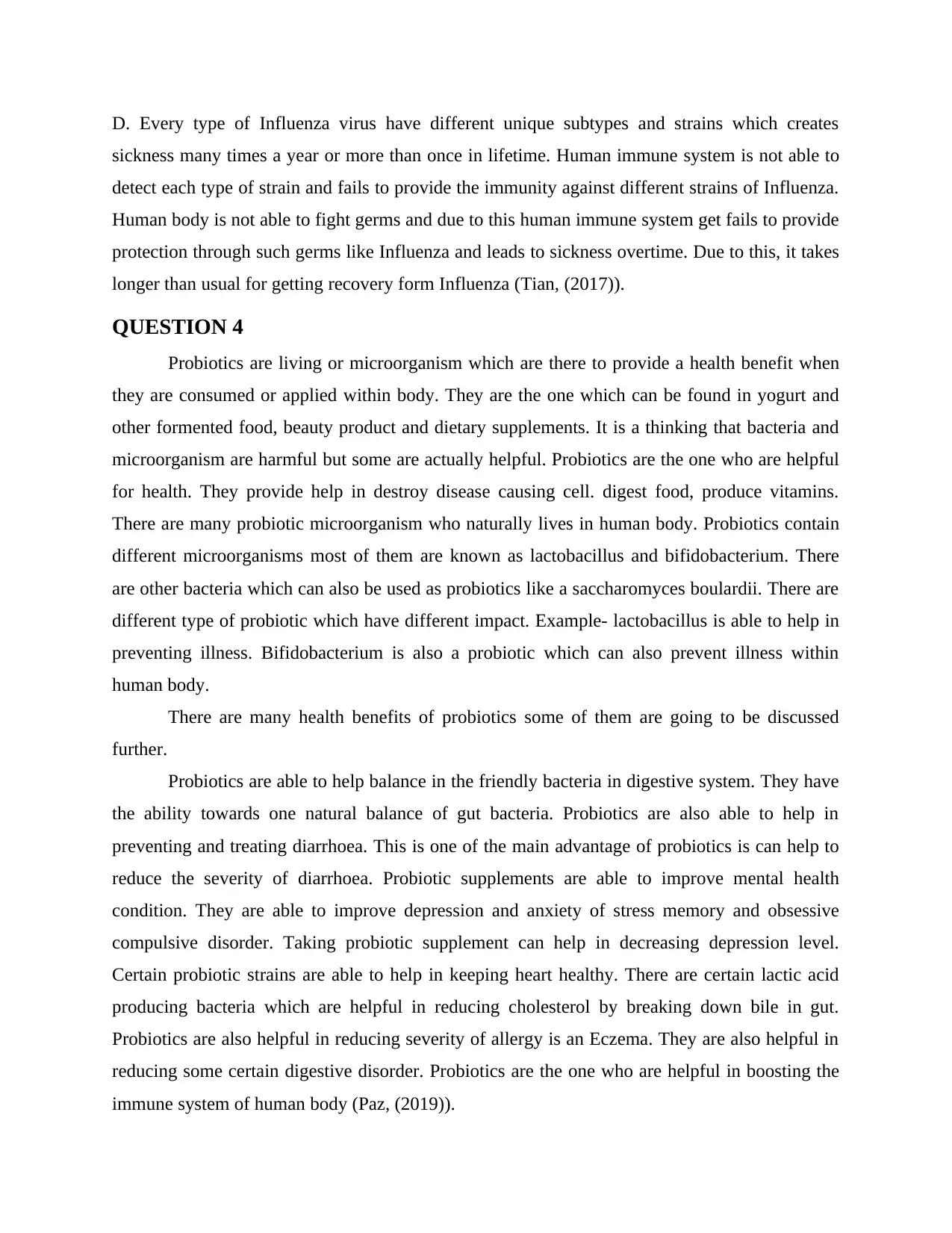
D. Every type of Influenza virus have different unique subtypes and strains which creates
sickness many times a year or more than once in lifetime. Human immune system is not able to
detect each type of strain and fails to provide the immunity against different strains of Influenza.
Human body is not able to fight germs and due to this human immune system get fails to provide
protection through such germs like Influenza and leads to sickness overtime. Due to this, it takes
longer than usual for getting recovery form Influenza (Tian, (2017)).
QUESTION 4
Probiotics are living or microorganism which are there to provide a health benefit when
they are consumed or applied within body. They are the one which can be found in yogurt and
other formented food, beauty product and dietary supplements. It is a thinking that bacteria and
microorganism are harmful but some are actually helpful. Probiotics are the one who are helpful
for health. They provide help in destroy disease causing cell. digest food, produce vitamins.
There are many probiotic microorganism who naturally lives in human body. Probiotics contain
different microorganisms most of them are known as lactobacillus and bifidobacterium. There
are other bacteria which can also be used as probiotics like a saccharomyces boulardii. There are
different type of probiotic which have different impact. Example- lactobacillus is able to help in
preventing illness. Bifidobacterium is also a probiotic which can also prevent illness within
human body.
There are many health benefits of probiotics some of them are going to be discussed
further.
Probiotics are able to help balance in the friendly bacteria in digestive system. They have
the ability towards one natural balance of gut bacteria. Probiotics are also able to help in
preventing and treating diarrhoea. This is one of the main advantage of probiotics is can help to
reduce the severity of diarrhoea. Probiotic supplements are able to improve mental health
condition. They are able to improve depression and anxiety of stress memory and obsessive
compulsive disorder. Taking probiotic supplement can help in decreasing depression level.
Certain probiotic strains are able to help in keeping heart healthy. There are certain lactic acid
producing bacteria which are helpful in reducing cholesterol by breaking down bile in gut.
Probiotics are also helpful in reducing severity of allergy is an Eczema. They are also helpful in
reducing some certain digestive disorder. Probiotics are the one who are helpful in boosting the
immune system of human body (Paz, (2019)).
sickness many times a year or more than once in lifetime. Human immune system is not able to
detect each type of strain and fails to provide the immunity against different strains of Influenza.
Human body is not able to fight germs and due to this human immune system get fails to provide
protection through such germs like Influenza and leads to sickness overtime. Due to this, it takes
longer than usual for getting recovery form Influenza (Tian, (2017)).
QUESTION 4
Probiotics are living or microorganism which are there to provide a health benefit when
they are consumed or applied within body. They are the one which can be found in yogurt and
other formented food, beauty product and dietary supplements. It is a thinking that bacteria and
microorganism are harmful but some are actually helpful. Probiotics are the one who are helpful
for health. They provide help in destroy disease causing cell. digest food, produce vitamins.
There are many probiotic microorganism who naturally lives in human body. Probiotics contain
different microorganisms most of them are known as lactobacillus and bifidobacterium. There
are other bacteria which can also be used as probiotics like a saccharomyces boulardii. There are
different type of probiotic which have different impact. Example- lactobacillus is able to help in
preventing illness. Bifidobacterium is also a probiotic which can also prevent illness within
human body.
There are many health benefits of probiotics some of them are going to be discussed
further.
Probiotics are able to help balance in the friendly bacteria in digestive system. They have
the ability towards one natural balance of gut bacteria. Probiotics are also able to help in
preventing and treating diarrhoea. This is one of the main advantage of probiotics is can help to
reduce the severity of diarrhoea. Probiotic supplements are able to improve mental health
condition. They are able to improve depression and anxiety of stress memory and obsessive
compulsive disorder. Taking probiotic supplement can help in decreasing depression level.
Certain probiotic strains are able to help in keeping heart healthy. There are certain lactic acid
producing bacteria which are helpful in reducing cholesterol by breaking down bile in gut.
Probiotics are also helpful in reducing severity of allergy is an Eczema. They are also helpful in
reducing some certain digestive disorder. Probiotics are the one who are helpful in boosting the
immune system of human body (Paz, (2019)).
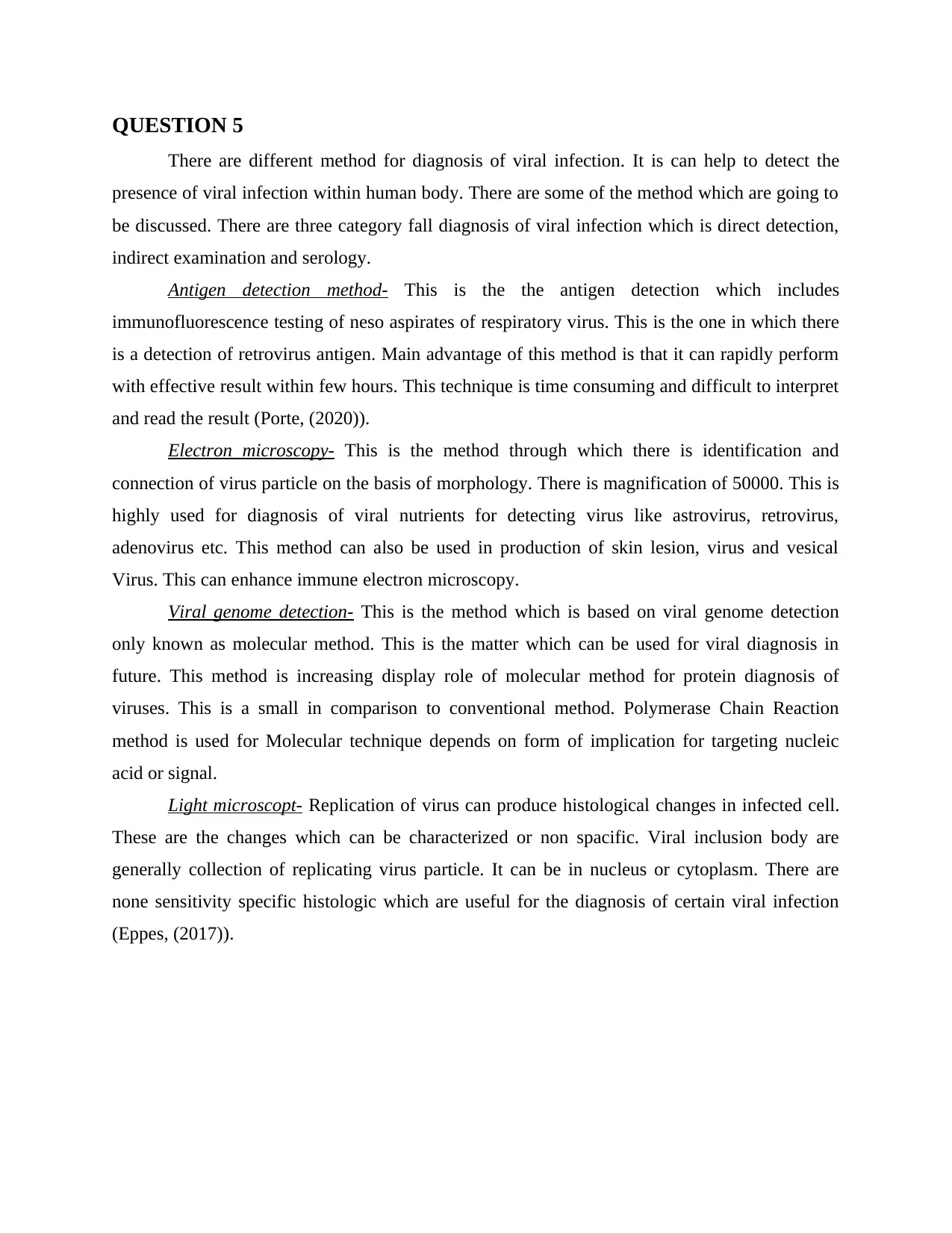
QUESTION 5
There are different method for diagnosis of viral infection. It is can help to detect the
presence of viral infection within human body. There are some of the method which are going to
be discussed. There are three category fall diagnosis of viral infection which is direct detection,
indirect examination and serology.
Antigen detection method- This is the the antigen detection which includes
immunofluorescence testing of neso aspirates of respiratory virus. This is the one in which there
is a detection of retrovirus antigen. Main advantage of this method is that it can rapidly perform
with effective result within few hours. This technique is time consuming and difficult to interpret
and read the result (Porte, (2020)).
Electron microscopy- This is the method through which there is identification and
connection of virus particle on the basis of morphology. There is magnification of 50000. This is
highly used for diagnosis of viral nutrients for detecting virus like astrovirus, retrovirus,
adenovirus etc. This method can also be used in production of skin lesion, virus and vesical
Virus. This can enhance immune electron microscopy.
Viral genome detection- This is the method which is based on viral genome detection
only known as molecular method. This is the matter which can be used for viral diagnosis in
future. This method is increasing display role of molecular method for protein diagnosis of
viruses. This is a small in comparison to conventional method. Polymerase Chain Reaction
method is used for Molecular technique depends on form of implication for targeting nucleic
acid or signal.
Light microscopt- Replication of virus can produce histological changes in infected cell.
These are the changes which can be characterized or non spacific. Viral inclusion body are
generally collection of replicating virus particle. It can be in nucleus or cytoplasm. There are
none sensitivity specific histologic which are useful for the diagnosis of certain viral infection
(Eppes, (2017)).
There are different method for diagnosis of viral infection. It is can help to detect the
presence of viral infection within human body. There are some of the method which are going to
be discussed. There are three category fall diagnosis of viral infection which is direct detection,
indirect examination and serology.
Antigen detection method- This is the the antigen detection which includes
immunofluorescence testing of neso aspirates of respiratory virus. This is the one in which there
is a detection of retrovirus antigen. Main advantage of this method is that it can rapidly perform
with effective result within few hours. This technique is time consuming and difficult to interpret
and read the result (Porte, (2020)).
Electron microscopy- This is the method through which there is identification and
connection of virus particle on the basis of morphology. There is magnification of 50000. This is
highly used for diagnosis of viral nutrients for detecting virus like astrovirus, retrovirus,
adenovirus etc. This method can also be used in production of skin lesion, virus and vesical
Virus. This can enhance immune electron microscopy.
Viral genome detection- This is the method which is based on viral genome detection
only known as molecular method. This is the matter which can be used for viral diagnosis in
future. This method is increasing display role of molecular method for protein diagnosis of
viruses. This is a small in comparison to conventional method. Polymerase Chain Reaction
method is used for Molecular technique depends on form of implication for targeting nucleic
acid or signal.
Light microscopt- Replication of virus can produce histological changes in infected cell.
These are the changes which can be characterized or non spacific. Viral inclusion body are
generally collection of replicating virus particle. It can be in nucleus or cytoplasm. There are
none sensitivity specific histologic which are useful for the diagnosis of certain viral infection
(Eppes, (2017)).
⊘ This is a preview!⊘
Do you want full access?
Subscribe today to unlock all pages.

Trusted by 1+ million students worldwide
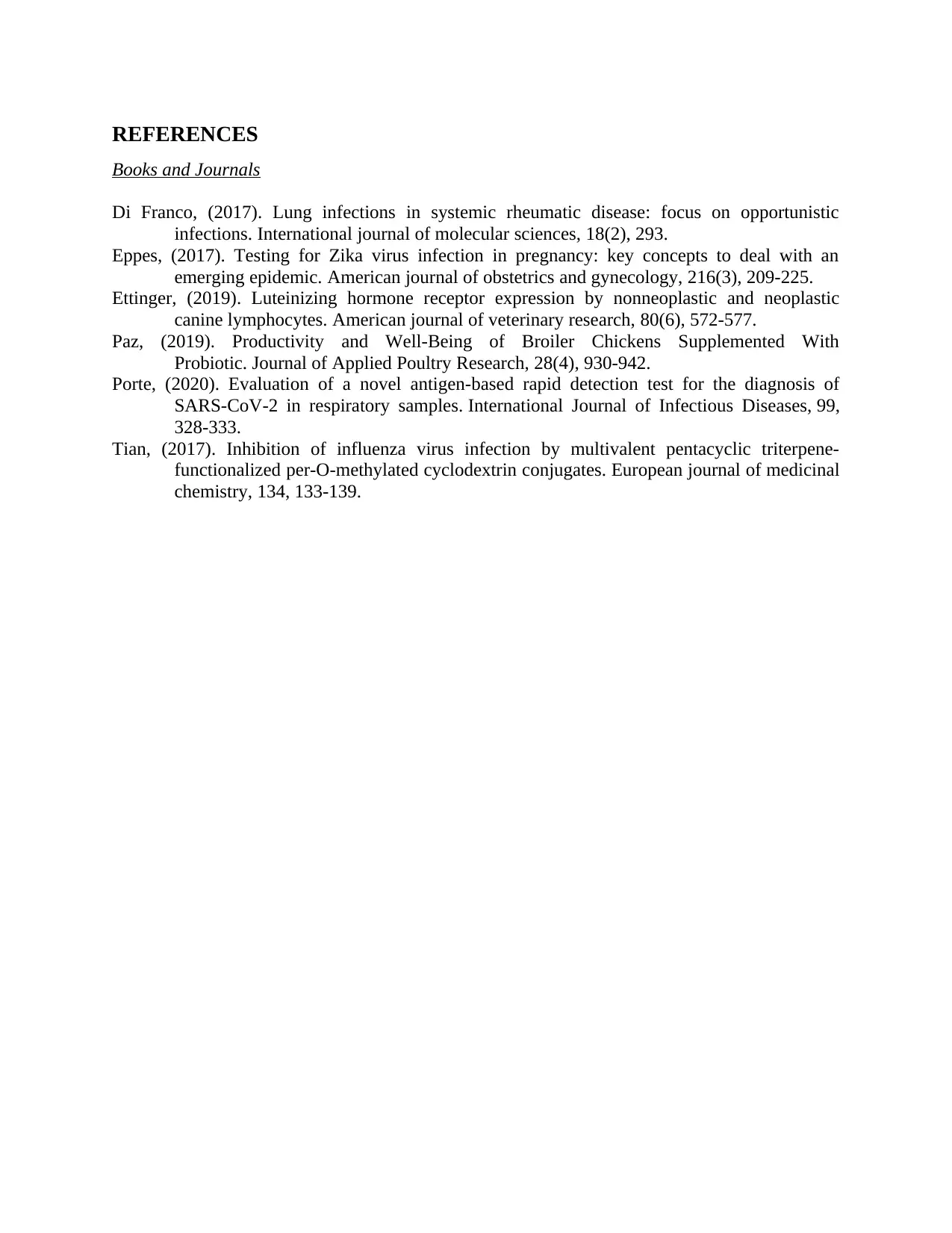
REFERENCES
Books and Journals
Di Franco, (2017). Lung infections in systemic rheumatic disease: focus on opportunistic
infections. International journal of molecular sciences, 18(2), 293.
Eppes, (2017). Testing for Zika virus infection in pregnancy: key concepts to deal with an
emerging epidemic. American journal of obstetrics and gynecology, 216(3), 209-225.
Ettinger, (2019). Luteinizing hormone receptor expression by nonneoplastic and neoplastic
canine lymphocytes. American journal of veterinary research, 80(6), 572-577.
Paz, (2019). Productivity and Well-Being of Broiler Chickens Supplemented With
Probiotic. Journal of Applied Poultry Research, 28(4), 930-942.
Porte, (2020). Evaluation of a novel antigen-based rapid detection test for the diagnosis of
SARS-CoV-2 in respiratory samples. International Journal of Infectious Diseases, 99,
328-333.
Tian, (2017). Inhibition of influenza virus infection by multivalent pentacyclic triterpene-
functionalized per-O-methylated cyclodextrin conjugates. European journal of medicinal
chemistry, 134, 133-139.
Books and Journals
Di Franco, (2017). Lung infections in systemic rheumatic disease: focus on opportunistic
infections. International journal of molecular sciences, 18(2), 293.
Eppes, (2017). Testing for Zika virus infection in pregnancy: key concepts to deal with an
emerging epidemic. American journal of obstetrics and gynecology, 216(3), 209-225.
Ettinger, (2019). Luteinizing hormone receptor expression by nonneoplastic and neoplastic
canine lymphocytes. American journal of veterinary research, 80(6), 572-577.
Paz, (2019). Productivity and Well-Being of Broiler Chickens Supplemented With
Probiotic. Journal of Applied Poultry Research, 28(4), 930-942.
Porte, (2020). Evaluation of a novel antigen-based rapid detection test for the diagnosis of
SARS-CoV-2 in respiratory samples. International Journal of Infectious Diseases, 99,
328-333.
Tian, (2017). Inhibition of influenza virus infection by multivalent pentacyclic triterpene-
functionalized per-O-methylated cyclodextrin conjugates. European journal of medicinal
chemistry, 134, 133-139.
1 out of 7
Related Documents
Your All-in-One AI-Powered Toolkit for Academic Success.
+13062052269
info@desklib.com
Available 24*7 on WhatsApp / Email
![[object Object]](/_next/static/media/star-bottom.7253800d.svg)
Unlock your academic potential
Copyright © 2020–2025 A2Z Services. All Rights Reserved. Developed and managed by ZUCOL.




